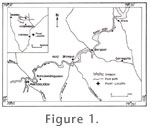|
|
INTRODUCTIONThe Kota Formation of Pranhita-Godavari Valley in peninsular India has been divided into two members–the Lower Member represented by sandstones and clays and the Upper Member characterised by a limestone zone followed by clays, mudstones, siltstones, and sandstones (Rudra 1982). The Lower Member yielded dinosaurs: Barapasaurus tagorei Jain et al. 1975, Kotasaurus yamanapalliensis Yadagiri 1988; mammals: Kotatherium haldanei Datta 1981, Indotherium pranhitai Yadagiri 1984 (=Indozostrodon simpsoni Datta and Das 2001), and wood fragments. A wide range of fossils have been reported from the limestones and intercalated mudstones and clays, and sandstones of the Upper Member. The faunal list from the Upper Member is represented by semionotid fishes: Lepidotes deccanensis Sykes 1851, Tetragonolepis oldhami Egerton 1878, Paradapedium egertoni Jain 1973; pholidophorid fishes: Pholidophorus kingi Yadagiri and Prasad 1977, P. indicus Yadagiri and Prasad 1977; a coelacanth fish: Indocoelacanthus robustus Jain 1974a; freshwater hybodont sharks: Lissodus indicus (Yadagiri 1986) Prasad et al. 2004,?Polyacrodus sp.(Prasad et al. 2004); anurans of uncertain affinity; a cryptodire turtle: Indochelys spatulata Datta et al. 2000; ?teleosaurid crocodiles (Owen 1852, Nath et al. 2002); undetermined teeth of ornithischian and theropod dinosaurs; sphenodontids: Rebbanasaurus jaini Evans et al. 2001, Godavarisaurus lateefi Evans et al. 2001; an iguanian lizard: Bharatagama rebbanensis Evans et al. 2002; pterosaurs: Campylognathoides indicus Jain 1974b, Rhamphorhynchus sp. (Rao and Shah 1963); and mammals: Trishulotherium kotaensis Yadagiri 1984, Nakunodon paikasiensis Yadagiri 1985, Paikasigudodon yadagirii (Prasad and Manhas 1997) and Dyskritodon indicus Prasad and Manhas 2002. In addition, ostracods (Govindan 1975, Misra and Satsangi 1979), estheriids (Tasch et al. 1973), insects (Rao and Shah 1959), charophytes (Feist et al. 1991, Bhattacharya et al. 1994), stromatolites and wood fragments (Gururaja and Yadagiri 1987, Rudra and Maulik 1987), have been documented from the Upper Member of the Kota Formation. Based on semionotid (Jain 1973) and pholodiphorid fishes (Yadagiri and Prasad 1977) an Early Jurassic (Liassic) age has been assigned to the Kota Formation. In contrast, the ostracod fauna favors a Middle Jurassic age (Govindan 1975). Finally, the latest palynological data indicated a late Middle Jurassic to Early Cretaceous age for this formation (Vijaya and Prasad 2001). Mammals from the Kota Formation have previously been referred to the "symmetrodontan" families Kuehneotheriidae (Kotatherium haldanei Datta 1981), incertae sedis (Trishulotherium kotaensis Yadagiri 1984) and Amphidontidae (Nakunodon paikasiensis Yadagiri 1985), and to the morganucodontan family Morganucodontidae (Indotherium pranhitai Yadagiri 1984). Indozostrodon simpsoni, referred to Megazostrodontidae (Datta and Das 2001), was synonymized with Indotherium pranhitai (Prasad et al. 2006). Kotatherium yadagirii Prasad and Manhas, 1997, originally described as a "symmetrodontan," was later redesignated as Paikasigudodon yadagirii and transferred to Megazostrodontidae (Prasad and Manhas 2002). However, Kielan-Jaworowska et al. (2004) tentatively placed Paikasigudodon in the eutriconodontan family Amphilestidae. In addition to these mammals, a new ?eutriconodontan tooth (Dyskritodon indicus Prasad and Manhas 2002) with affinities to the North African genus Dyskritodon, one fragmentary left lower molar exhibiting some amphilestid features (Prasad and Manhas 2002) and two upper premolars possibly related to dryolestids (Prasad et al. 2006) have been described from the Kota Formation.
Cusp nomenclature used in this paper is that of Butler (1997). Measurements were taken with a micrometer attached to Censico STB III A stereoscopic microscope. Institutional AbbreviationsVPL/JU/KM - Vertebrate Palaeontology Laboratory, University of Jammu, Kota Mammals, India; USNM – National Museum of Natural History, Washington, D.C, USA; MNHN – Muséum national d'Histoire naturelle, Paris, France; BMNH J – Natural History Museum, London, United Kingdom; VJ – Museum of Serviços Geológicos de Portugal, Lisbon, Portugal. |
|
